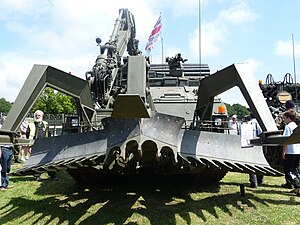Trojan (vehicle)
| Trojan | |
|---|---|

A Trojan AVRE on display at Bovington Camp
|
|
| Type | Combat engineering vehicle |
| Place of origin |
|
| Service history | |
| In service | 2007–present |
| Used by | Royal Engineers |
| Wars | Operation Moshtarak, Afghanistan (since 2010) |
| Production history | |
| Manufacturer | BAE Systems Land Systems |
| Unit cost | ~£4,217,000 ~$6,694,400 ~€5,338,860 |
| Produced | 2004– |
| No. built | 33 |
| Specifications | |
| Weight | 62.5 tonnes (61.5 long tons; 68.9 short tons) |
| Length |
8.3 m (27 ft 3 in) 11.50 m (37 ft 9 in) |
| Width |
3.5 m (11 ft 6 in) 4.2 m (13 ft 9 in) with appliqué armour |
| Height | 2.5 m (8 ft 2 in) |
| Crew | 3 (commander, operator, driver) |
|
|
|
| Armour | Chobham/Dorchester Level 2 (classified), |
|
Main
armament |
7.62 mm L94A1 (remote controlled) |
| Engine |
Perkins CV-12 Diesel 1,200 hp (890 kW) |
| Power/weight | 19.2 hp/t (14.2 kW/t) |
| Transmission | David Brown TN54 epicyclic transmission (6 fwd, 2 rev.) |
| Suspension | Hydropneumatic |
|
Operational
range |
450 km (280 mi) |
| Speed |
59 km/h (37 mph) 40 km/h (25 mph) off road |
8.3 m (27 ft 3 in)
3.5 m (11 ft 6 in)
59 km/h (37 mph)
The Trojan Armoured Vehicle Royal Engineers (AVRE) is a combat engineering vehicle of the British Army. It is used to breach minefields and for many other tasks. It is currently in use with the Royal Engineers.
The Trojan Armoured Vehicle Royal Engineers is based on a Challenger 2 tank chassis, but lacks the main armament. In place of the turret, it has a large hydraulic excavator arm, which can be used to excavate areas, move obstacles, and deposit the fascine that the Trojan carries at its rear. The Trojan is usually also fitted with a plough on the front, which enables it to clear mines, either detonating them on contact, or pushing them out of the way to clear a safe channel for following vehicles.
For self-defence only, it carries a 7.62mm machine gun.
For rapid mine-clearing purposes, the Trojan can also tow a trailer carrying the Python, a rocket-propelled hose similar to the Giant Viper. This allows for a much quicker way of clearing a path for ground forces. The hose, packed with explosive, is launched across a minefield, and detonates after it hits the ground, clearing a 7-metre wide path for 230 metres.
The vehicles were built at BAE Systems Land Systems plant in Newcastle upon Tyne. The contract was awarded in 2001 to Vickers Defence Systems, who were bought by BAE Systems in 2004. The project was known as the Future Engineer Tank. 33 have been built.
It was first used on exercise in May 2007 with the 1st Battalion (Mechanised) of the Duke of Lancaster's Regiment.
A number of Trojans are permanently based in Canada at British Army Training Unit Suffield in order to allow the Royal Engineers to support Armoured Battle Groups on major exercises.
...
Wikipedia
